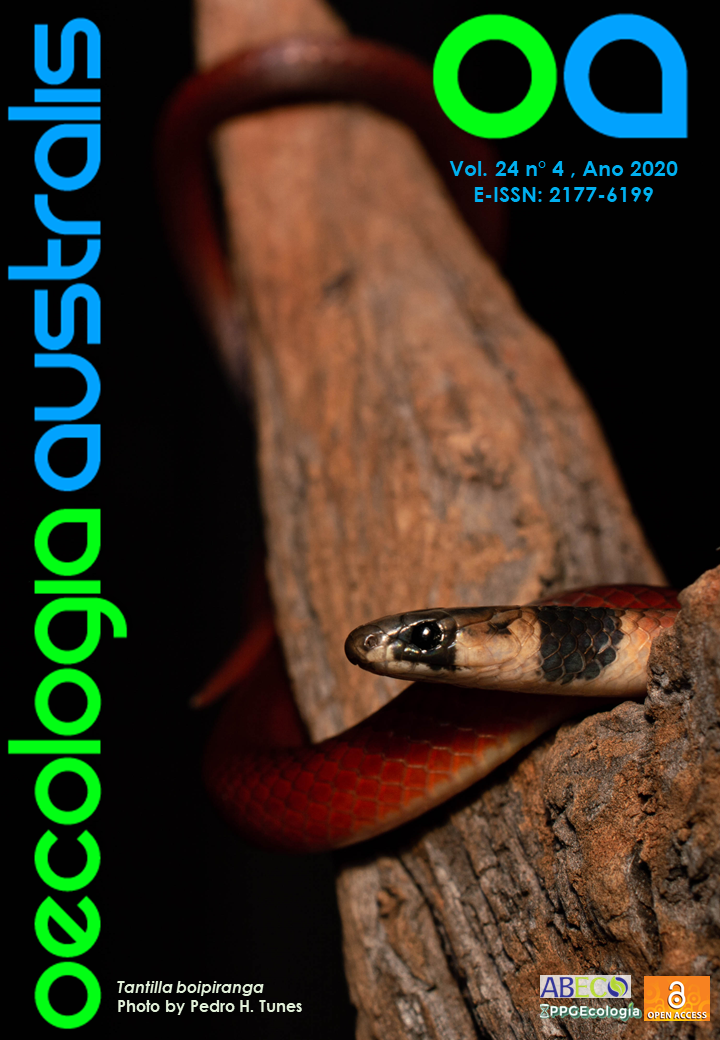POPULATION FLUCTUATION OF TETRANYCHUS URTICAE (ACARI: TETRANYCHIDAE) IN DIFFERENT CHRYSANTHEMUM VARIETIES IN GREENHOUSES
DOI:
https://doi.org/10.4257/oeco.2020.2404.19Keywords:
flower shop, population density, two-spotted spider miteAbstract
OThis research aimed at verifying the population fluctuation of the phytophagous spider mite Tetranychus urticae in four chrysanthemum (Chrysanthemum morifolium Ramat: Asteraceae) cultivars: Convington (Yellow - CVT), Kalamazoo (White - KLZ), White diamond (Cream - WD) and Royal Time (Pink - RT). Samples were taken every two weeks during two production cycles (March to April and August to October). In each sampling, leaves from 20 chrysanthemum plants were collected from each cultivar, one apical and one basal (40 leaves/cultivar sample). A total of 583 T. urticae individuals were collected, 41.9 % of the individuals in WD, 38.0 % in KLZ, 15.1 % in RT and 5.0 % in CVT. There were no significant differences in the populational density among the evaluated varieties (p > 0.05). Thus, the results indicated no significant differences in plant susceptibility to the phytophagous mite, suggesting that the four varieties are equally adapted to avoid T. urticae attack.
References
Baker, E. W., & Tuttle, D. M., 1994. A guide to the spider mites (Tetranychidae) of the United States. West Bloomfield: Indira Publishing House: p. 347.
Barbosa, J. G., Grossi, J. A. S., Barbosa, M. S., & Stringheta, A. C. O., 2005. Cutting chrysanthemum cultivation. Agricultural Report, 26(227), 36–43.
Brackmann, A., Bellé, R. A., Freitas, S. T., & Mello, A. M., 2005. Postharvest qualities of chrysanthemums (Dendranthema grandiflora) maintained in gibberellic acid solution. Rural Science, 35(6), 1451–1455. DOI: 0.1590/s0103-84782005000600037
Callegari-Jacques, S. D. 2006. Bioestatística. Princípios e Aplicações. Porto Alegre: Artmed: p. 255.
Dicke, M. 1998. Infochemicals in tritrophic interactions. Origin and function in a system consisting of predatory mites, phytophagous mites and their host plants. Doctoral thesis. Agricultural University, Wageningen: p. 235.
Esteves Filho, A. B, Oliveira, J. V., Torres, J. B., & Gondim Jr, M. G. C. 2010. Comparative biology and behavior of Tetranychus urticae Koch (Acari: Tetranychidae) e Phytoseiulus macropilis (Banks) (Acari: Phytoseiidae) in cotton bollgardTM and non-transgenic isolinha. Neotropical Entomology, 39(3), 338–344. DOI: 10.1590/s1519-566x2010000300005
Gallo, D., Nakano, O., Neto, S.S., Carvalho, R.P.L., Batista, G.C., Filho, E.B., Parra, J.R.P., Zucchi, R.A., Alves, S.B., Vendramim, J.D., Marchini, L.C., J.R.S. Lopes, J.R.S., & Omoto, C. 2002. Entomologia agrícola, Piracicaba, FEALQ: p. 920.
Gotelli, N. J. &, Ellison, A. M. 2011. Princípios de Estatística em Ecologia. Porto Alegre: Artmed: p. 576.
Grbic, M., Van Leeuwen, T., Clark, R. M., Rombauts, S., Rouzé, P., Grbic, V., Osvorne, E.J., Wannes, D., Ngoc, P.C.T., Ortego, F., Hernández-Crespo, P., Diaz, I., Martinez, M., Navajas, M., Sucena, E., Magalhães, S., Nagy, L., Pace, R.M., Djuranovic, S., Smagghe, G., Iga, M., Christiaens, O., Veenstra, J.A., Ewer, J., Villalobos, R.M., Hutter, J.L., Hudson, S.D., Velez, M., Yi, S.V., Zeng, J., Silva, A.P., Roch, F., Cazaux, M., Navarro, M., Zhurov, V., Acevedo, G., Bjelica, A., Fawcett, J.A., Bonnet, E., Martens, C.; Baele, G., Wissler, L., Sanchez-Rodriguez, A., Tirry, L., Blais, C., Demeestere, K., Henz, S.R., Gregory, T.R., Mathieu, J., Verdon, L., Farinelli, L., Schmutz, J., Lindquist, E., Feyereisen, R., & Peer, Y.V. 2011. The genome of Tetranychus urticae reveals herbivorous pest adaptations. Nature, 479: 487–492. DOI:10.1038/nature10640.
Hammer, Ø., Harper, D. A. T., & Ryan, P. D. 2001. Past: Paleontological Statistics Software Package for Education and Data Analysis. Palaeontologia Electronica, 4(1), 1–9.
Lourenção, A.L., Moraes, G. J., Passos, F. A., Ambrosano, G. M. B., & Silva, L. F. 2000. Resistance of strawberries to Tetranychus urticae Koch (Acari: Tetranychidae). Annals of the Entomological Society of Brazil, 29(2), 339–346. DOI: 10.1590/S0301-80592000000200016.
Maruyama, W.I., Toscano, L.C., Boiça Júnior, A.L., & Barbosa, J.C. 2002. Resistance of tomato genotypes to brindle mite. Brazilian Horticulture, Brasilia, 20(3), 480–484. DOI:10.1590/s0102-05362002000300017.
Moraes, G. J., & Flechtmann, C. H. W. 2008. Acarology manual: basic acarology and mites from plants cultivated in Brazil. Ribeirão Preto: Holos: p. 288.
Moro, L. B., Polanczyk, R. A., Carvalho, J. R., Pratissoli, D., & Franco, C. R. 2012. Biological parameters and life table of Tetranychus urticae (Acari: Tetranychidae) in papaya cultivars. Rural Science, 42(3), 487–493. DOI:10.1590/s0103-84782012000300016
Norboo, T., Ahmad, H., Shankar, U., Ganai, S. A., Kumar, M., & and Stanzin Landol, B. K. 2018. Screening for resistance in rose against red spider mite, Tetranychus urticae (Linn.). Journal of Entomology and Zoology Studies. 6(3): 897–899
Pallini, A., Janssen, A., & Sabelis, M. W. 1997. Odour-mediated responses of phytophagous mites to conspecific and heterospecific competitors. Oecologia, 110(2), 179–185. DOI:10.1007/s004420050147
Poletti, M., Maia, A. H. N., & Omoto, C. 2007. Toxicity of neonicotinoid insecticides to Neoseiulus californicus and Phytoseiulus macropilis (Acari: Phytoseiidae) and their impact on functional response to Tetranychus urticae (Acari: Tetranychidae). Biological Control, 40(1), 30–36. DOI:10.1016/j.biocontrol.2006.09.001
Reddy, S. G. E., Urvashi, C., Sapana, K., Gireesh, N., & Singh, M.K. 2014. Comparative bio-efficacy of acaricides against two spotted spider mite, Tetranychus urticae (Koch) on chrysanthemum in Polyhouse. Research in Chemistry and Environment, 4(4), 15–19.
Streck, N. A. 2004. A temperature response function for development of the chrysanthemum (Chrysanthemum x morifolium Ramat.). Ciência Rural, 34(1), 49–54. DOI:10.1590/s0103-84782004000100008
Sulzbach, M., Ott, R., Schafer, G., & Ott, A. P. 2015. Abundance and seasonality of two-spotted spider mite on gerbera cultivars. Ciência Rural, 45(4), 578–584. DOI:10.1590/0103-8478cr20131494
Sunil, K., Niki, D., Choupoo, A. S., Marak, B. S., & Debonroy, D. 2018. Genetic variability and correlation in chrysanthemum (Chrysanthemum morifolium Ramat) genotypes. HortFlora Research Spectrum, 7(1), 33–40.
Uddin, N., Alam, Z., Miah, R. U., Mian, I. H., & Mustarin, K. E. 2015. Toxicity of pesticides to Tetranychus urticae Koch (Acari: Tetranychidae) and their side effects on Neoseiulus californicus (Acari: Phytoseiidae). International journal of acarology, 41(8), 688–693. DOI:10.1080/01647954.2015.1094512
Villanueva-Couoh, E., Alcántar-González, G., Sánchez-García, P., Soria-Fregoso, M., & Larque-Saavedra, A. 2009. Efecto del ácido salicílico y dimetilsulfóxido en la floración de [Chrysanthemum morifolium (Ramat) Kitamura] en Yucatán. Revista Chapingo, 15, 25–31. DOI:10.5154/r.rchsh.2009.15.046
Zar, J. H. 1996. Biostatistical Analysis. 3ª ed. New Jersey: Prentice-Hall Internacional: p. 662.
Zhang, Z. Q. 2003. Mites of greenhouses: identification, biology and control. CAB International, Wallingford: p. 244. DOI:10.1079/9780851995908.0000


